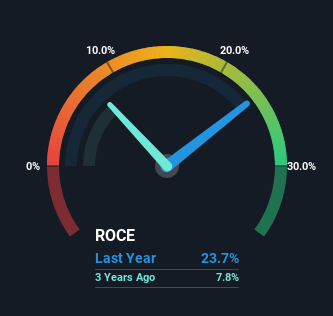Why The 24% Return On Capital At Sula Vineyards (NSE:SULA) Should Have Your Attention

Finding a business that has the potential to grow substantially is not easy, but it is possible if we look at a few key financial metrics. One common approach is to try and find a company with returns on capital employed (ROCE) that are increasing, in conjunction with a growing amount of capital employed. Ultimately, this demonstrates that it's a business that is reinvesting profits at increasing rates of return. And in light of that, the trends we're seeing at Sula Vineyards' (NSE:SULA) look very promising so lets take a look.
What Is Return On Capital Employed (ROCE)?
Just to clarify if you're unsure, ROCE is a metric for evaluating how much pre-tax income (in percentage terms) a company earns on the capital invested in its business. Analysts use this formula to calculate it for Sula Vineyards:
Return on Capital Employed = Earnings Before Interest and Tax (EBIT) ÷ (Total Assets - Current Liabilities)
0.24 = ₹1.4b ÷ (₹9.0b - ₹3.0b) (Based on the trailing twelve months to September 2023).
Therefore, Sula Vineyards has an ROCE of 24%. That's a fantastic return and not only that, it outpaces the average of 16% earned by companies in a similar industry.
View our latest analysis for Sula Vineyards

Above you can see how the current ROCE for Sula Vineyards compares to its prior returns on capital, but there's only so much you can tell from the past. If you're interested, you can view the analysts predictions in our free report on analyst forecasts for the company.
What The Trend Of ROCE Can Tell Us
We like the trends that we're seeing from Sula Vineyards. The data shows that returns on capital have increased substantially over the last four years to 24%. Basically the business is earning more per dollar of capital invested and in addition to that, 43% more capital is being employed now too. So we're very much inspired by what we're seeing at Sula Vineyards thanks to its ability to profitably reinvest capital.
One more thing to note, Sula Vineyards has decreased current liabilities to 33% of total assets over this period, which effectively reduces the amount of funding from suppliers or short-term creditors. This tells us that Sula Vineyards has grown its returns without a reliance on increasing their current liabilities, which we're very happy with.
The Bottom Line
All in all, it's terrific to see that Sula Vineyards is reaping the rewards from prior investments and is growing its capital base. And investors seem to expect more of this going forward, since the stock has rewarded shareholders with a 74% return over the last year. Therefore, we think it would be worth your time to check if these trends are going to continue.
One more thing to note, we've identified 2 warning signs with Sula Vineyards and understanding these should be part of your investment process.
If you'd like to see other companies earning high returns, check out our free list of companies earning high returns with solid balance sheets here.
New: Manage All Your Stock Portfolios in One Place
We've created the ultimate portfolio companion for stock investors, and it's free.
• Connect an unlimited number of Portfolios and see your total in one currency
• Be alerted to new Warning Signs or Risks via email or mobile
• Track the Fair Value of your stocks
Have feedback on this article? Concerned about the content? Get in touch with us directly. Alternatively, email editorial-team (at) simplywallst.com.
This article by Simply Wall St is general in nature. We provide commentary based on historical data and analyst forecasts only using an unbiased methodology and our articles are not intended to be financial advice. It does not constitute a recommendation to buy or sell any stock, and does not take account of your objectives, or your financial situation. We aim to bring you long-term focused analysis driven by fundamental data. Note that our analysis may not factor in the latest price-sensitive company announcements or qualitative material. Simply Wall St has no position in any stocks mentioned.
About NSEI:SULA
Sula Vineyards
Manufactures, purchases, and sells wine and other alcoholic beverages.
Adequate balance sheet with moderate growth potential.
Market Insights
Community Narratives



